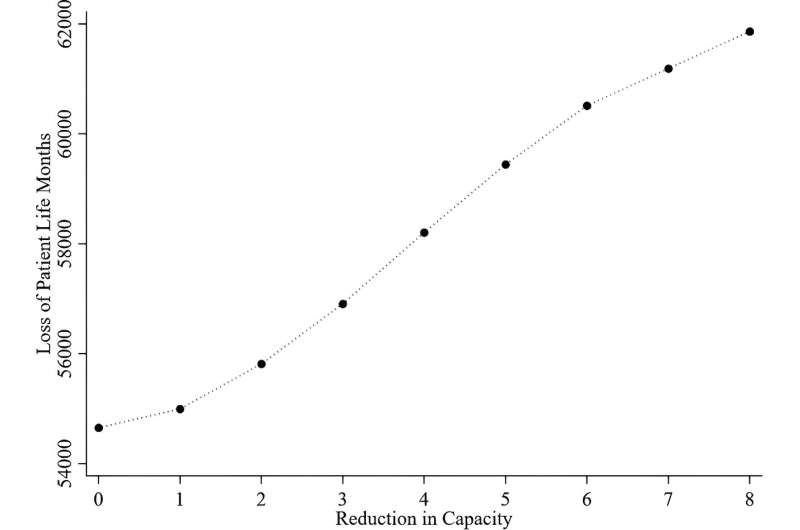
Impact of overall-capacity constraints on the loss of patient life months. Note: This figure depicts the impact of overall-capacity constraints on the loss of patient life months. The results are estimated based on scenario 1 (see Table 6) and the nation-guidance tiered shutdown policy. Credit: Production and Operations Management (2022). DOI: 10.1111/poms.13697
The COVID-19 pandemic disrupted organ transplants in unprecedented ways. Many transplant centers considered slowing down and even pausing all transplants, mostly due to the potential risk of COVID-19 to organ donors, transplant recipients and care providers.
In a study published in Production and Operations Management on managing pandemics, two operations management researchers from The University of Texas at Dallas analyzed the impact of pausing transplants on patient outcomes. Their findings could help decision-makers determine whether and how to pause organ transplants during a pandemic.
Management science doctoral student Minmin Zhang and Dr. Guihua Wang, assistant professor of operations management in the Naveen Jindal School of Management, developed a model for evaluating the impact of pausing liver transplants. The model accounts for two potential risks: COVID-19 infection in the case of no pause and health deterioration in the case of a pause.
“We found that while pausing organ transplants reduced the risk of infections and saved scarce health care resources for COVID-19 patients, patients on the waiting list became sicker while waiting for organ transplants,” Wang said. “Policymakers, care providers and patients must balance the trade-off between the risks of infection and health deterioration.”
The researchers used more than 12 years of liver transplant data from the United Network for Organ Sharing and a system of differential equations to calculate the threshold probability—the cutoff value at which a decision-maker is indifferent between pausing and continuing organ transplants.
“The threshold probability represents a decision rule: When the risk of a pandemic is high—that is, the mortality rate due to a pandemic is higher than the threshold probability we calculate—a decision-maker may consider pausing organ transplants,” Wang said. “Otherwise, they may continue organ transplants. By following this decision rule, a decision-maker can reduce the harm to patients due to the pandemic.”
To calculate the threshold probability for a specific transplant center, the researchers considered multiple parameters, including the rate of patients arriving at the center, the rate of patients getting transplants, the likelihood that a patient’s health status changes without a transplant, a patient’s expected life months with or without a transplant, and how long organ transplants are paused.
While the threshold probability differs across transplant centers, Zhang said, the study suggests that a decision-maker should be cautious in pausing liver transplants for patients with MELD-Na (model for end-stage liver disease-sodium) scores of 16 or higher when the risk of a pandemic is unknown. MELD-Na scores range from six to 40. The higher the score, the greater the patient’s chances of dying without a liver transplant in the next three months.
The study’s results support the recommendations of the Centers for Medicare & Medicaid Services and the American Society of Transplantation that organ transplants should not be paused.
The researchers also compared different pause policies and analyzed how hospital capacity constraints during a pandemic affect the loss of patient life months and the length of the transplant waiting list.
They found that a tiered shutdown policy that considers the heterogeneity across different categories of patients is superior to a complete shutdown policy. They also found that a center-specific policy that considers the heterogeneity across different centers is superior to a nationwide policy.
“Regardless of the phase of the pandemic, our findings suggest that the center-specific, tiered shutdown policy is a more accurate response to a pandemic and leads to better outcomes for patients,” Zhang said. “However, this policy requires individual transplant centers to collect and analyze data to consider the differences between centers and the differences between categories of patients. It also requires policymakers to align incentives for transplant centers and patients.”
A pandemic might also affect organ transplants indirectly if the capacity of transplant centers is reduced due to the redirection of scarce health care resources such as medical staff and beds.
“The pandemic reduced the number of health care staff available for donor evaluation, organ recovery and transplant screening tests,” Wang said. “It also reduced the number of health care resources, such as ICU beds and ventilators, that are essential for organ transplants.”
They found that as the overall capacity is reduced, the loss of patient life months and the average number of extra patients on the waiting list increase.
The researchers said their model can be applied to other solid-organ transplants, such as kidney transplants, or procedures that require urgent intervention, such as cancer surgeries.
More information:
Minmin Zhang et al, Pausing transplants in the face of a global pandemic: Patient survival implications, Production and Operations Management (2022). DOI: 10.1111/poms.13697
Citation:
Study measures impact of pausing organ transplants in pandemic (2023, August 10)
retrieved 10 August 2023
from https://medicalxpress.com/news/2023-08-impact-transplants-pandemic.html
This document is subject to copyright. Apart from any fair dealing for the purpose of private study or research, no
part may be reproduced without the written permission. The content is provided for information purposes only.
>>> Read full article>>>
Copyright for syndicated content belongs to the linked Source : Medical Xpress – https://medicalxpress.com/news/2023-08-impact-transplants-pandemic.html































